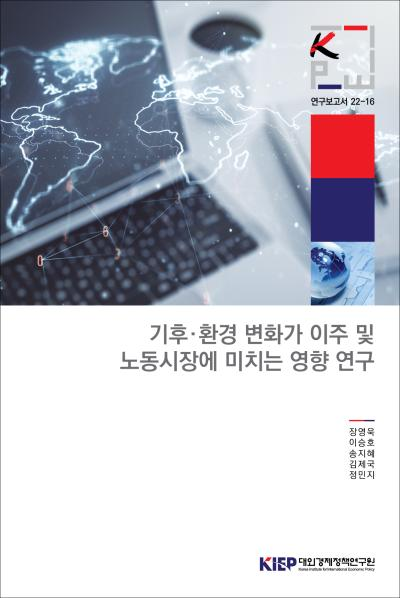Policy Analyses
PUBLISH
Policy Analyses
To list

Effects of Environmental Changes on Migration and Labor Market Outcomes
International immigration, Labor market
Author Youngook Jang, Seungho Lee, Jihei Song, Jegook Kim, and Minji Jeong Series 22-16 Language Korean Date 2022.12.30
This report provides a comprehensive investigation of environmental migration, which is expected to accelerate in the future due to the direct and indirect effects of climate change and natural disasters. The report is the first Korean-language study to address the various aspects of environmental migration and employs various research methods, including field research, expert interviews, case studies, literature review, and empirical analysis.
Chapter 2 classifies migration due to climate and environmental factors into three categories: i) displacement due to extreme weather events and disasters, ii) displacement due to gradual climate change, and iii) displacement due to a combination of factors. It reviews the current status, cases, and prospects of each category. This chapter also highlights the impact of various environmental factors such as typhoons, floods, extreme heat events, earthquakes, and volcanic eruptions, which can cause immediate displacement of large numbers of people.
Chapters 3 through 5 conduct case studies in Central America, Africa, and Southeast Asia, respectively. Chapter 3 provides case studies of Mexico, Guatemala, El Salvador, and Honduras, examining how climate change and the frequent occurrence of intense natural disasters are linked to migration in these countries. In these countries, declining agricultural productivity, particularly among subsistence farmers and seasonal laborers, is likely to worsen the socioeconomic situation, leading them to choose migration as a last resort climate change adaptation mechanism.
Chapter 4 examines climate and environmental factors and migration trends in Morocco, Senegal, Nigeria, and Somalia. This chapter illustrates how climate change and environmental change are driving migration in these countries through case studies and field research. The impact of drought on migration in Morocco, Senegal, and Nigeria is particularly significant, with increased internal, international, temporary, and permanent migration due to drought. The more agriculturally dependent and drought-affected communities are, the more likely they are to choose to migrate themselves or their family members as an adaptation to environmental change.
Chapter 5 explores the cases of environmental migration in four Southeast Asian countries: the Philippines, Indonesia, Vietnam, and Thailand. The findings presented in the chapter reveal that the Philippines experienced the most severe environmental impacts, with the highest increase in temperature and precipitation, and the most frequent natural disasters such as storms and floods, leading to the highest number of out-migrants. Indonesia also faced frequent floods and earthquakes, resulting in significant human and economic losses and domestic migration due to natural disasters accounting for the majority of migration. While Thailand experienced less severe floods and storms than the other countries, the back-to-back floods in 2010 and 2011 displaced over 2.5 million people.
Chapter 6 reviews the literature and conducts empirical analysis to examine the impact of climate and environmental change on migration and labor markets. The analysis shows how temperature changes, precipitation changes, and natural disaster in sending or receiving countries have a significant impact on bilateral migration. Additionally, environmental change is found to lead to migration outflows only in low- and middle-income countries, while income decline has a deterrent effect on migration in low-income countries. This chapter also highlights the scarcity of research on the impact of climate change on labor markets as a route to migration and suggests expanding research in this area.
Finally, in Chapter 7, the report draws policy implications based on its findings. The chapter recommends expanding humanitarian assistance to migrants, strengthening international and development cooperation on climate change mitigation and adaptation, and improving administrative procedures to accommodate the increasing influx of foreign labor. The report emphasizes the need for proactive predictions on the demand and supply of foreign labor and elaborating strategies to accommodate them, given the anticipated demographic changes in South Korea. While the report does not propose specific policy alternatives, its findings are recommended as a basis for future policy responses.
Sales Info
| Quantity/Size | 264 |
|---|---|
| Sale Price | 10 $ |
 공공저작물 자유이용허락 표시기준 (공공누리, KOGL) 제4유형
공공저작물 자유이용허락 표시기준 (공공누리, KOGL) 제4유형
대외경제정책연구원의 본 공공저작물은 "공공누리 제4유형 : 출처표시 + 상업적 금지 + 변경금지” 조건에 따라 이용할 수 있습니다. 저작권정책 참조
